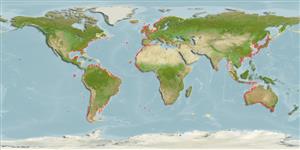Common names from other countries
Environment: milieu / climate zone / depth range / distribution range
Écologie
; profondeur 0 - 32 m (Ref. 87801). Tropical
Indo-Pacific, Atlantic Ocean and the Mediterranean.
Length at first maturity / Taille / Poids / Âge
Maturity: Lm ? range ? - ? cm Max length : 0.3 cm WD mâle / non sexé; (Ref. 2992)
Minimum depth from Ref. 116013. Benthic, found on hard substrate (Ref. 116013). This species is found on polychaete tubes, dead gorgonians, wood and dock chains at depths of 10 to 32 m (Ref. 87801).
Life cycle and mating behavior
Maturité | Reproduction | Frai | Œufs | Fécondité | Larves
Species exhibits both asexual and sexual reproduction by budding during hydroid stage and release of gametes in medusae stages (Ref. 1663, p. 14, 17).
Cairns, S.D., D.R. Calder, A. Brinckmann-Voss, C.B. Castro, D.G. Fautin, P.R. Pugh, C.E. Mills, W.C. Jaap, M.N. Arai, S.H.D. Haddock and D.M. Opresko. 2003. (Ref. 1663)
Statut dans la liste rouge de l'IUCN (Ref. 130435)
statut CITES (Ref. 108899)
Not Evaluated
Not Evaluated
Utilisations par l'homme
| FishSource |
Outils
Plus d'informations
Taille/Âge
Croissance
Longueur-poids
Longueur-longueur
Morphologie
Larves
Abondance
Sources Internet
Estimates based on models
Preferred temperature
(Ref.
115969): 7.6 - 28, mean 18.7 (based on 822 cells).
Vulnérabilité
Low vulnerability (10 of 100).
Catégorie de prix
Unknown.
